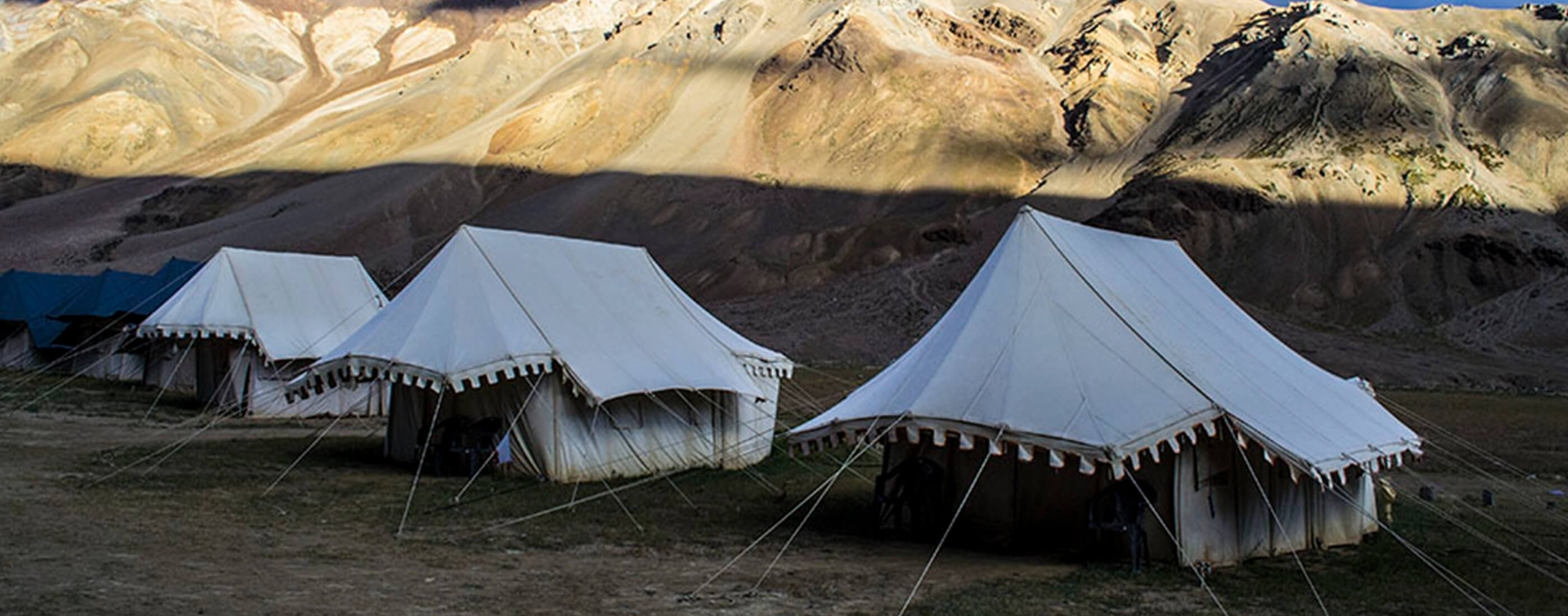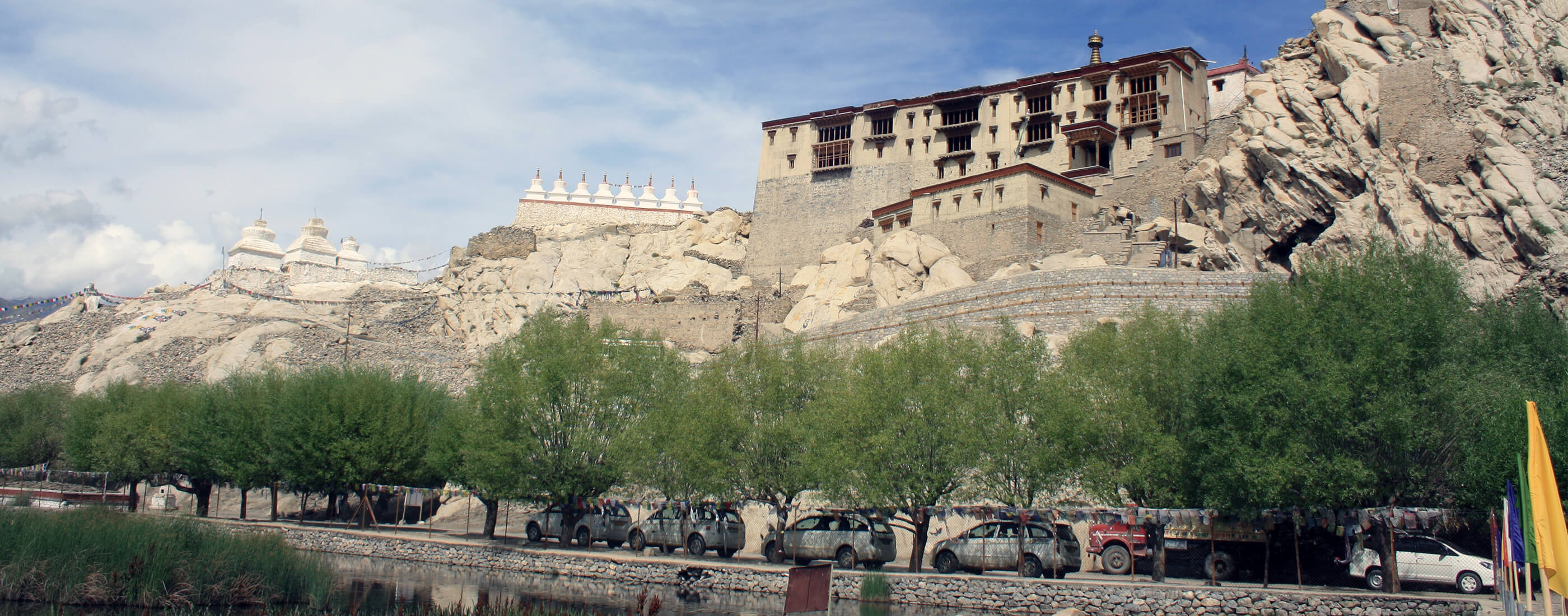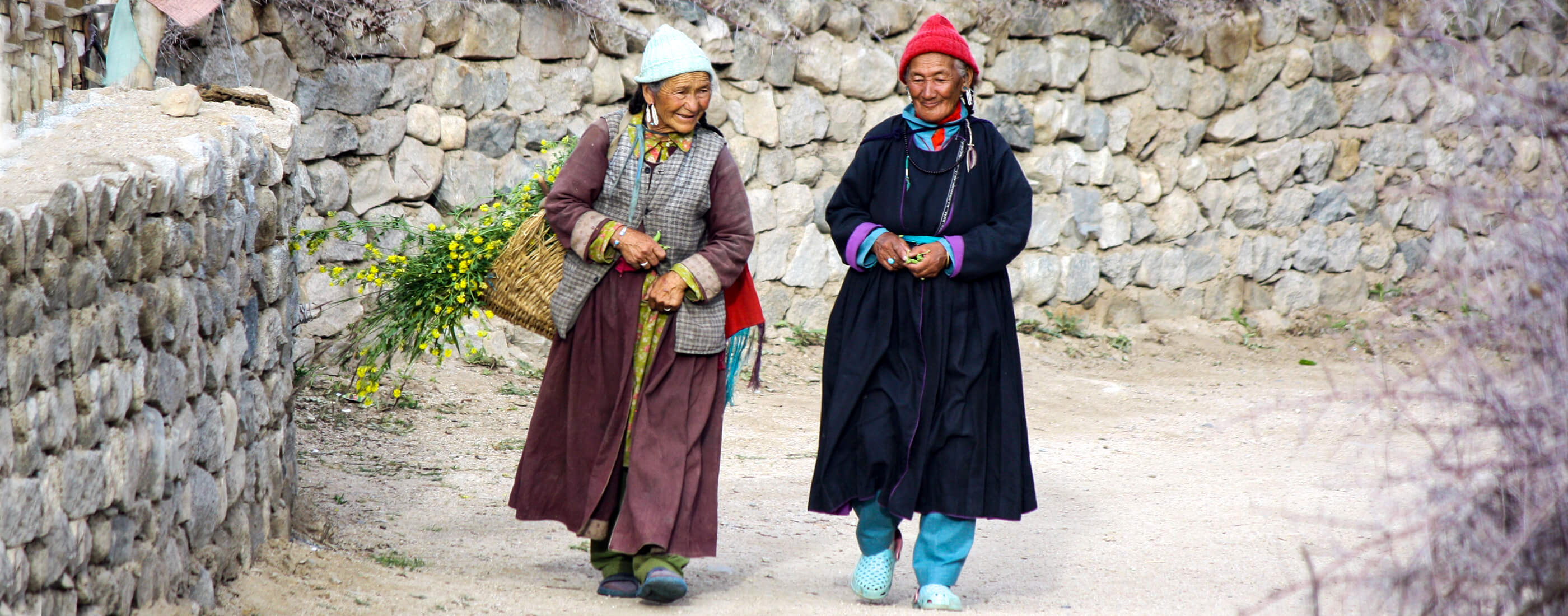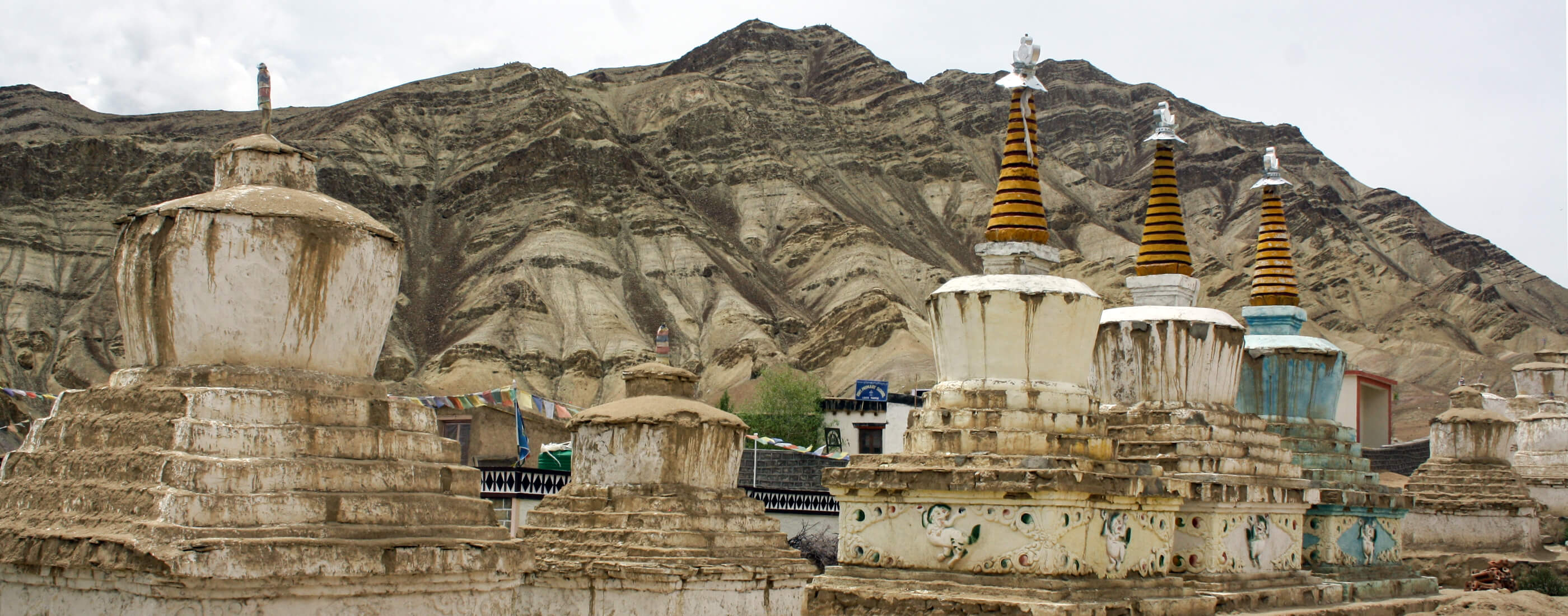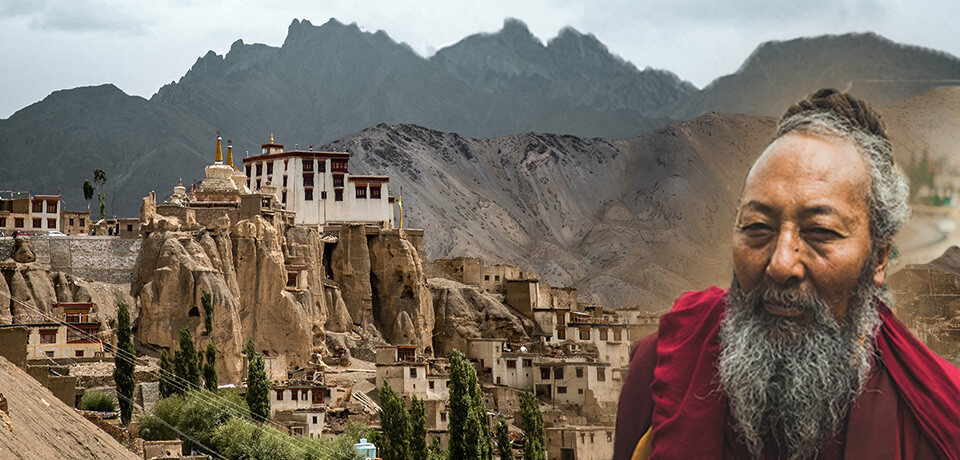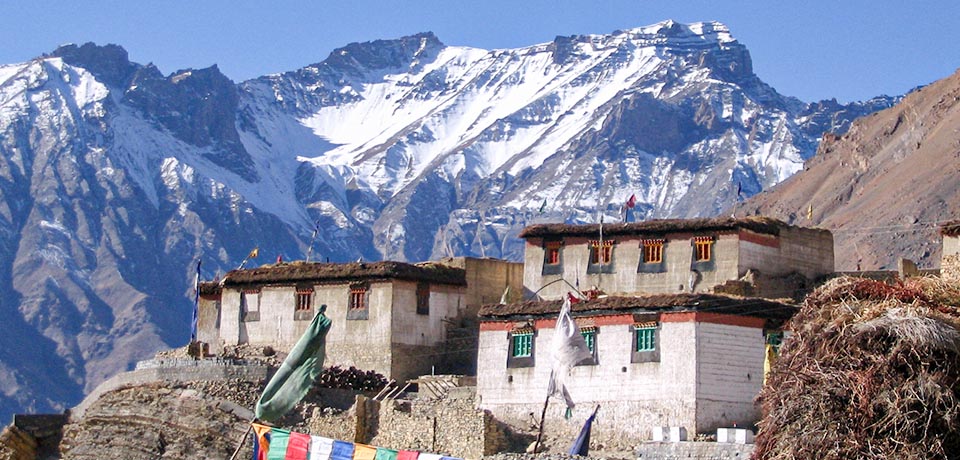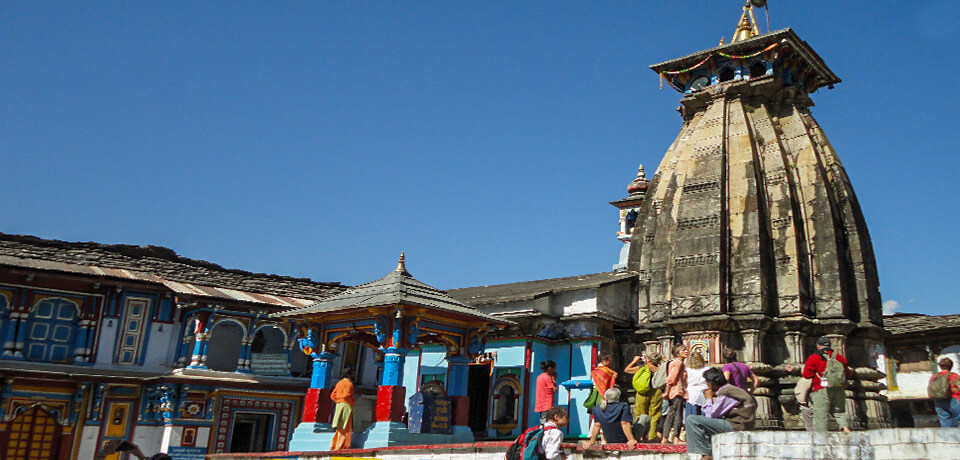Trans Himalayan Journey
Amritsar to Leh : Diverse culture, tradition and fascinating landscapeDay 1: Arrive Delhi by evening
Day 2: Delhi to Amritsar by train, Visit Golden temple
Day 3: Amritsar to Dharamsala, 190 kms, 6 hours’ drive. (Via Kangra), Brijeshwari Temple
Day 4: Visit Dharamshala (1830 m). Namgyal monastery and Norbulinga
Day 5: Dharamsala to Mandi (760m) 126 kms. Via Rewalsar 1360m.
Day 6: Mandi to Kullu-Manali (2000m) 90 kms.
Day 7: Explore Manali: Ancients temples, typical Himalayan villages and culture
Day 8: Manali- Jispa
Day 9: Jispa -Purne (3900m) Over Baralachala(4800m) Shingola (5090m) 150kms, 6h
Day 10: Excursion to Phucktal gompa 3h30, Padum 3650m (via Cha-Reru-Barden) 50 kms. 4/5h
Day 11: Padum-Saini - Karsha -Tongdey- 45 kms. Day excursion
Day 12: Padum –Zangala -Lingshed (3900m)-Lamayuru (3450m)180 kms. 8/9h.
Day 13: Lamayuru -Temisgam- Alchi 50 kms. (3200m) Leh (3500m) 120 kms
Day 14: Monasteries of Indus valley (Thiksey- Hemis- Stakana)
Day 15: Leh-Delhi flight and departure.
Day 1 Arrive Delhi
Arrive Delhi by evening, reception at airport, Transfer to the hotel, Night in hotel.
Day 2: Delhi- Amritsar. By train 6h.
Morning transfer to Railway station, train to Amritsar, on arrival transfer to hotel. Amritsar translates as “pool of nectar” is surrounding the Sikh Golden Temple. A causeway connects to the temple in the middle of the pool. A Sikh high priest reads the holy book, sitting on the east side of the temple, and attracts pilgrims from all over the world. Visit one of the biggest community kitchens in the world. Most fascinating action of work here is done by volunteers who help to peel, chop, cook, wash dishes and serve free meals to thousands of devotees. By afternoon visit Bagha border to attend the retreat ceremony (or Parade) that takes place on grand trunk road between India (Amritsar) and Lahore (Pakistan) is an incredible experience at sun set. By evening, you can attend the closing ceremony of sacred book, and enjoy the serenity of golden temple.
Day 3 Amritsar to Dharamsala, Mcleodganj, (1830m) 190 kms, 6h.
Leave for Dharamsala, En route visit thousand-year old Brijeshwari Temple dominating old Kangra town, built in Shikara style and dedicated to the goddess Brijeshwari. The 10-minute walk leading to the temple premises is through decorated alley with colorful shops selling articles that devotees need for religious rituals to pay homage to the goddess. At afternoon, check-in at the hotel and later in the evening, stroll with Indo-Tibetan crowd on the street of Mcleodganj. A former colonial retreat rose to prominence after the large-scale exodus of Tibetans from their homeland in 1959. It is the residence (Ocean of Tranquility) of His Holiness, the Dalai Lama. In the backdrop are the majestic Dhauladhar Mountains. The Tibetan Government in exile has been based here for over decades, with traditional architectural designs drawn from Tibet, Night in hotel.
Day 4 Visit Dharamsala (1830 m)
Morning visit to the impressive Namgyal monastery is surrounded by a row of prayer wheels that houses larger-than-life images of Buddha: Padmasambhava and Avalokteshwara. Tsuglagkhang complex is the most important Buddhist monument of McLeodganj and has an interesting collection of sacred texts based on the teaching of Buddha, the center of medicine and astrology. Visit the Norbulingka Institute and its museum. This Tibetan Arts Museum seeks to promote the study and representation of the Tibetan performing arts to ensure their preservation. We may have the opportunity to meet the monks, (some time close for the renovation and for the Tibetan festive events) the Tibetan handicraft center can also be visited. Night in hotel.
Day 5: Dharamsala to Mandi (760m) 126 kms. Via Rewalsar 1360m.
Leave to Mandi, En route take glimpse on tea estate of Palampur on the foothills of Dhauladhar range, Short stop to visit Shiva temple at Baijnath dedicated to Vaidhyanath. The temples are built in the Shikara style and are remarkable for their proportion and architectural beauty. Drive further to Rewalsar (Pool of Ancient Wisdom), which is like a Dark jewel on a wooded hillside. This sacred lake is identified as the “Sahar of Yore”. Legend identifies this place as the one from where Padmasambhava left for Tibet to spread the words of the Buddha in the 8th century. Mandi is an important town of Himachal Pradesh and gateway to Kullu Valley. It is known for its aesthetically carved Shikara style temples of Bhootnath, Triloknath and Panchvakra. Stroll in Old Street which lead to the series of above said temple. Night in hotel.
Day 6: Mandi to Kullu-Manali (2000 m), 90 kms.
Today, we leave for Manali. En route visit Shiva temple at Bajaura before Kullu town. Kullu–Manali is situated in the inner range of the Himalayas and is famous for apple orchards, pine trees and cheerful people. The valley has hundreds of temples and deities. The Aryans named this valley as Kulantpitha, meaning “the end of the habitable world”. Once reached, visit temple of Manu at old Manali village, evening free to stroll in new Manali, night in hotel.
Day 7: Exploration around Manali
Leave to visit pagoda shape wooden temple of Goddess Hadimba that is famous for its association with Mahabharata, located in middle of giant cedar forest. Further to Nagar castle is a mountain architecture example of the valley. Over view on another wooden temple of Pagoda shape dedicated to Goddess Tripura sundry, the well-known art Gallery of Russian painter Nicolas Roerich, Stroll in typical Himalayan village. Evening back to Manali. Night in the hotel.
Day 8: Manali to Jispa-90 kms via Keylong . 3200m. 96 kms
Uphill drive along Beas river, cross the Tunnel (9kms) of Rohtang range of Himalaya to enter to Lahoul valley surrounded by high mountain scape, hanging glaciers, waterfall and is known for its production of potato and vegetable. Continue following Chandra river crossing several villages till Keylong the head quarter of tribal district of Lahoul and Spiti. Take 3kms of uphill drive by narrow road (if road is open) till Shashur Gompa dominating entire valley, facing magnificent snowcapped mountains. A 16th century gompa belongs to the red hat sect of Tibetan Buddhism or Drukpa order and have spiritual connection with the Lion Cave Temple of Bhutan. Late afternoon reach at Jispa, stroll around or relax in fix camp or in hotel.
Day 9: Jispa – Purne (3900m) Over Baralachala(4800m) Shingola (5090m) 150kms, 5h Drive
Day start by short stop at check point in Darcha. Bit above the Darcha take diversion to right side. Your over land adventure continue on ancients epic route of the trek between Darcha and Leh was popularly known as Grand traverse of Zanskar. Earlier the only way possible to get in to the isolated Zanskar was the trek and now the newly built road (track at the places) opens the door to those who are eager to seeking of the new horizons. Road wind through last inhabited villages of Lahoul “Rarik and Chhika“ snake curved road brings you to the top of mighty Shigola pass ( 5090m) which is the gate way between Lahoul (Himachal) and Zanskar ( Ladakh). Take a shortstop on the pass to appreciate the scenery of snowy peaks. Zing-Zag descend to the valley, follow the Kargyak Chhu underneath of legendary Gomparangjum peak stand high as spiritual sentinel of the valley. You may encounter the herds of Yaks and marmots paying hide and seek. Kargyak the first village of valley is reached. Take a short walk and continue your drive till Purni. Night in camp/ home stay.
Day 10: Excursion by walk to Phucktal gompa 3h30, Padum 3650m (via Cha-Reru-Barden) 50 kms. 4/5h
To explore the exclusive site there required some extra efforts (Those who don’t wish to walk can stay at Purne to relax). Two hours of walk at the place is flat, paved to up and down and cliffy. Follow the opposite flow of Tserap River. After crossing the bridge, you will be amazed when appears an incredible site at the distance, housed in the sheer cliffy cave right above the river below is the astonishing Phucktal Gompa. Phucktal belongs to the tradition of the Gelugpas (Yellow hats). The spring that gurgles deep in the cave is still out of bound to the women. The Hungarian historian Cosma de Koros stayed there over the winter of 1825-26. It houses the mural paintings, statues, library where stored the sacred books and around 70 monks live here. One can meet the monks who may be busy in their daily routine schedule. Back to Purni, night in same place. After lunch, follow the Tserap River, villages Surley and Pipula remain opposite side. On the way take a stroll in Reru village to have the glimpse of local life style. Next stop at Bardan monastery belong to the Druk Kagyupa is famous for its prayer wheel and grand statue of Budha. Reach Padum is administrative headquarter of Zanskar sub-division. Night in hotel
Day 11: Padum-Saini -Karsha -Tongdey-. 45 kms.
Day excursion Leave to Saini Gompa, it belongs to the Drukpa Kargyu school of Tibetan Buddhism. Have stroll in the village to have the glimpse on the life of local peoples in the valley. Drive opposite side of valley to appreciate the stunning view of Zanskar mountain range amidst villages and farm land till Karsha monastery, stunningly located above Karsha village is very much picturesque. It belongs to gelugpa order (yellow hate) of Tibetan Buddhism, it was founded by the translator, Phagspa Shesra. Monastery house wall paintings, Statue of Avaloketeshwara and many more statues, where resides around 40 monks who perform the prayers and other activities Stongdey monastery. Located high above the village on the cliff. Provide the stunning beauty of its surrounding mountains and the valley where Zanskar river born after by confluence of Doada and Tserap rivers and flows in middle throughout till it merge in Indus. Eleventh century monastery belongs to Gelukpa order is the second largest of monastic institution. Around 60 Lamas reside here. Back to Padum, night in hotel.
Day 12: Padum – Zangala -Lingshed (3900m)-Lamayuru (3450m) 180 kms. 8/9h. Over (Skiumpate la-4200m). Singila (5100m) and Sirsirla (4800m)
Leave early, on the way visit Zangala, the ancient capital of Zanskar kingdom, Fort in ruin is still visited is the architectural example of the valley, located strategically on the rocky outcrop high above to have the village in clear view. Stroll in the village to admire the local rustic houses and to encounter the villages. Continue following the river toward north, opposite side is the trekking route that leads to Lamayuru with some of tinny hamlets and giant colorful Rocky Mountains rise high to the sky. After a while you will enter into the magnificent multicolor narrow gorge with its high towering spire, at the beneath where roar the Zanskar river is just one of the mesmerizing parts of the trip. Exit of the gorge leads by narrow valley where clear stream amidst the Willow shrubs meander. After while you will reach Lingshed village with its large farmland and high rocky wall behind. visit the monastery belongs to the Gelugpa order and is built in 1440s. Ascend to (Skiumpate la-4200m) following the epic scenic trekking route over magnificent Singila (5100m), picturesque Phutokasar village, Sirsirla ( 4800m), Hanupata village and last few kms of drive amidst sheer rocky gorge to Lamayuru. Visit monastery, one of the ancient monasteries magnificently perched on the hill. Before Buddhism penetrated in the region this site was known as a center for Bon religion. Stroll around the monastery campus and admire the stunning beauty of landscape, night in a simple hotel.
Day 13: Lamayuru -Temisgam- Alchi 50 kms. (3200m) Leh (3500m) 120 kms
We leave to Temisgam, a small hidden oasis located in the heart of a grand and mineral landscape known for the production of ales and apricot. Visit palace built in 1460 A.D. next step to the monastery of Temisgam. Monastery houses magnificent fresco of statues. Visit nunnery to discover the life of women in the isolated monastery. On the way second major attraction is Alchi. Alchi monastery among the many temples, caves and Stupas built in Ladakh is the largest and the most famous of all of them, built by Rinchen Zangpo about 990 years ago. Monastery houses valuable mural painting and Thankas. Drive to Leh, Evening short visit to Leh Town, Night in hotel.
Day 14: Monasteries of Indus valley (Thiksey- Hemis- Stakana)
Leave early to visit most famous monasteries of Indus valley. Visit Thiksey a majestic monastery perched on a rocky outcrop built in the 15th century during the first wave of expansion of Gelugpa sect in Ladakh. At the entrance, there are painting of protective deities and the great masters of the sect. Hemis Monastery: Hemis Gompa is established in1620 by Lama Tagstang Raspa and built by Palden Sara under the patronage of King Singe Namgyal. Its mural painting represents the different divinities dated back to 18th sanctuary and belongs to the Drukpa sect of Buddhism. Way back visit 16th century Stakana monastery belongs to Drukpa Kagyu order is only Bhutaneese monastery in Ladakh. Stakana literally means the nose of tiger due to its location of the hill on top of which the monastery is built. It house statue of Arya Avalokiteshwara which was brought from Kamrup in Assam. Around 30 monks reside here. Afternoon back to Leh. Evening stroll / drive to Shanti Stupa and Leh Bazar. Night in hotel.
Day 15: Leh-Delhi flight and departure.
Flight to Delhi, visit spice market and colourful streets of Chandani chowk in old Delhi by Tricycle rickshaw to mingle with real Indian folk. Visit grand Mosque (closed on prayer hours) and take outer view of red fort. After lunch free time for souvenir shops. Few rooms are allotted for wash and change. Evening transfer to airport and fly out toward your destination,
No hotel in Delhi
Note: Please be sure that your insurance covers your all expenses in high altitude as of ground or air rescue during your expedition in case of accident, altitude sickness if helicopter required: We request you to provide Himalayan Frontiers the Insurance number, policy number, 24 hours emergency contact of insurance, persons in your family to be contacted if need be.
Contact us for the optional choices of the extension:
1: Same day Agra to visit Taj Mahal.
2: One night two days Agra to visit Taj Mahal.
3: Golden Triangle of 3 nights 4 days.
4: Varanasi or Banaras for 2 nights 3 days.
Cost for less than 4 persons
Cost per person—- €1830 based on 2 Person
Formed groups: If you are a group of more than 8 persons, please contact us to get the special deal.
Proposed Dates: If the proposed dates doesn’t suite to those who are already formed group of individuals, families, friends, club or corporates, we can tailor their trip for the date that match to their holidays schedule for the suitable period when your trip can be conducted.
COST INCLUDE
COST EXCLUDE
Lunch
International air fare
Monument fees.
Visa and airport tax.
Insurance
Beverages and personal expenses.
Medical expenses and evacuation.
Tipping
Any other expanse occurred due to the road block and flight cancellation etc

Trans Himalayan Journey
India ModerateRegion: Punjab- Himachal Pradesh & Ladakh
Activity: Discovery Tour
Season: 15 June- September
Duration: 15 days
Highlights
Amritsar: The Centre of Sikh religion
Dharamshala: Ancient Hindu temples, Buddhist monasteries and Tibetan Government in exile
Rewalsar: Sacred lake and Buddhist monasteries.
Kullu-Manali: Stunning beauty of nature and mountain culture
Rural and isolated regions of Zanskar valley
Buddhist culture and ancients monasteries
Deep gorges and sky touching sheer rocky towers
Meandering river amid the valleys
Interaction with hospitable people and monks
Well preserved authentic culture and tradition
Ladakh once the important halt for the caravan of silk route
Stunning landscape, multicolor hue and oasis
New Delhi: Glimpse on the capital of India.

